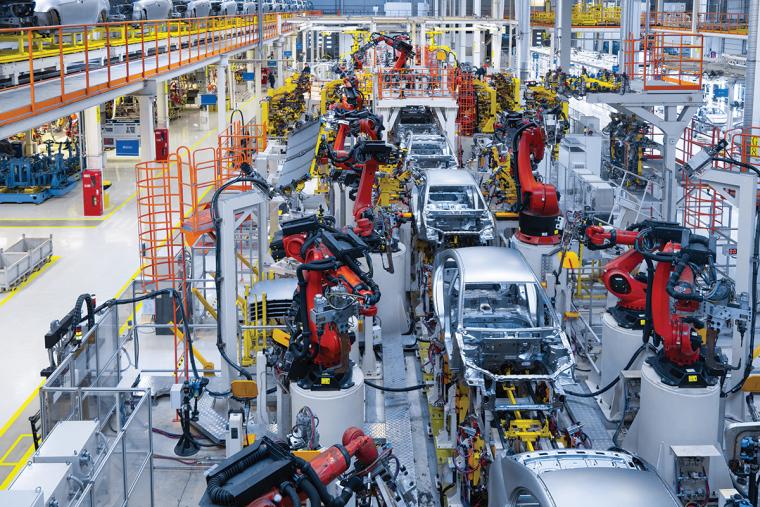

Despite an unforeseen global crisis setting the stage for 2020, the automotive industry’s response to the public’s healthcare needs has been remarkable. Companies such as General Motors, Mercedes AMG, Ford and Tesla have retooled their production capabilities to produce ventilators, CPAP devices and other much-needed medical equipment for COVID-19 patients and healthcare providers.
The financial arms of Chrysler, Ford, Honda, Hyundai, Mercedes-Benz, Nissan and others have offered options for payment deferral, late fee waivers and other financial difficulty exceptions for individuals impacted by the crisis. In the EU, companies have even provided vehicles, logistical support and other resources to ensure access to critical services. The automotive industry has played and will continue to play an essential role in responding to the crisis. But how exactly will the role be defined in the ongoing economic recovery?
A Look in the Rear-View Mirror
First, one should understand the numbers. A review of the Local Area Unemployment Statistics (LAUS) data indicates that 5.58 million Americans were unemployed at the end of 2019. As of April 2020, the most recent, non-preliminary data show that number had surged to 22.26 million – an increase of nearly 300 percent.
While millions are out of work entirely, others are adjusting to a work-from-home paradigm that has disrupted commuting patterns and business practices. State-imposed travel restrictions have caused many vehicles to remain permanently parked. With so many people unemployed and others working from home, it is easy to understand the correlation as to why new car sales have plummeted. On June 2, CNBC reported that new vehicle sales in May were down 33 percent compared to the prior year.
On the production side, most U.S. auto assembly plants closed earlier this spring, with 93 percent of production halted as of March 26. Some plants were online by mid-June, but many were not at full production capacity. What remains unclear is whether a second wave of infections, supply chain challenges or other factors will cause plants to slow or even close again, further impacting new vehicle supplies.
Looking to used car sales, early April numbers plummeted during the height of stay-at-home orders nationwide, but since mid-May, have reached parity with 2019 sales. And while we saw used cars sitting on lots during the height of the pandemic, that excess supply has now been absorbed by shoppers who were looking for a deal. The question is: did they get one?
Interestingly, used car inventories, measured in “days of supply,” are now below 2019 levels at the time of this writing in June, suggesting a lack of trade-ins and private sales to dealerships as Americans tighten their budgets and delay upgrading to a new vehicle. According to the Manheim Used Vehicle Index, car values have increased by four percent compared to June 2019. Prices remain steady and may continue to increase depending on how long coronavirus restrictions remain in place.
The shocks to supply and demand, lack of discretionary income, low consumer sentiment and outright financial hardship highlight the need for diversification and adaptability within the entire industry. But while Americans hold tightly to their used vehicles, automotive manufacturers have an eye toward recovery. They are presenting a multitude of financing options to move people back into the new car driver’s seat.
Revving the Economic Engine Back to Life
Following the 2008 financial crisis, new car sales rallied as consumer sentiment changed. North American vehicle production hovered around 16 million until the market crashed, and production dropped to only nine million units in 2009. By 2012, production rebounded to the 16-million-unit level, creating a deep “V” pattern. That pattern is a stark reminder of both the personal financial burden faced by many Americans and the speed with which the industry was able to rebound.
Importantly, production and sales rates can be altered by financial incentives as well, which are typically available through attractive financing terms. Major automotive companies are using this tactic to bolster their bottom line to make it through this difficult time. The strategy centers around turnover rather than margin; automakers are sacrificing profitability, preferring to move cars as they roll off the production line to maintain positive cash flow, thus weathering the storm. Every major automaker has announced such a deal, from zero percent financing for an extended period of time to aggressive cash-back and closing credit options.
Automakers derive a substantial amount of income through financing vehicle sales. These financial services are typically set up as wholly owned subsidiaries of the more familiar car brand. Considering that approximately 85 percent of new car sales include financing, the stakes are significant when it comes to accumulating credit risk. According to a recent report by the Federal Reserve Bank of Richmond, outstanding vehicle debt ballooned from $791 billion at the end of 2008 to $1.33 trillion at the end of 2019.
The issue with using financial incentives as a solution is it assumes a temporary problem. When the COVID-19 response began to take shape in March, many thought it would pass in a matter of weeks. Indeed, the discussion centered around “flattening the curve” so America could get back to work much sooner. With social distancing and masking orders extended into July, many experts now assume this healthcare crisis will persist for at least another six months, if not longer.
Bumps and Bypasses Ahead
The road ahead, therefore, is potentially obstructed by several key factors. First, will the major auto brands’ financial arms be able to withstand a surge in default rates? The Federal Reserve reports default rates peaked after the Great Recession at 5.27 percent. Alarmingly, default rates have been on the rise since 2018, and as of the end of 2019, they were just below five percent. The Fed estimates that for every one percent increase in the unemployment rate, the vehicle default rate may increase by 0.54 percent.
Fortunately, policymakers have already begun taking action to alleviate some of the pressure through legislation such as the CARES Act. However, automakers should carefully consider the potential impact of continuing to offer aggressive financing terms in the face of a prolonged financial downturn.
The second key factor is the global supply chain’s ability to withstand additional closures, as the vulnerabilities of the worldwide economy are exposed. Importing electronics from Asia, tires from Africa and mechanical parts from Europe has served automakers well – until now. While that strategy is sound following a period of temporary closures, it is unclear whether multiple waves will impact supply chains to such a degree that cash flow cannot be maintained. For that reason, automakers should begin to explore a reshoring of operations in the United States, which will mitigate future risks associated with far-reaching supply lines. Undoubtedly, this will come at a high cost; however, it also presents several opportunities.
Reshoring supply chains will allow automakers to comply with the United States – Mexico – Canada Agreement (“NAFTA 2.0”) that was signed in 2019 and ratified in 2020. That trade deal requires 75 percent of auto content to be made in North America (up from 62.5 percent), as well as 40 to 45 percent of auto content to be made by workers earning at least $16 per hour. Given that these provisions went into effect on July 1, 2020, automakers have undoubtedly explored their supply chains to ensure future compliance. The NAFTA 2.0 rules may provide additional justification for revamping those networks.
Automakers also have an opportunity to revisit the Made in America tax credit provisions of Internal Revenue Code (IRC) Section 250. While that section of the tax code has done little to move the needle on reshoring, it may be an added benefit to a potential restructuring now that the paradigm has shifted away from globalization. That provision would reduce the corporate tax rate from 21 percent to 13 percent on exports. Domestic manufacturers with foreign subsidiaries may find that reshoring production in the United States allows them to take advantage of tax breaks that are more beneficial than local or regional cost efficiencies abroad.
The third factor affecting economic recovery is the reaction to the level of disruption over the last five years. Traditionally, the industry’s innovation was limited to improvements in horsepower, fuel economy, safety and quality of life features. The rise of hybrid and electric cars as environmentally friendly, affordable alternatives to the daily drivehas offered a new level of competition amongst the major brands. For a market that has been so resistant to change in the past, several disruptors have entered the space in recent years, causing familiar brands to rethink their strategies and play catch up on the latest trends.
Will the Future Drive Itself?
Perhaps the most daunting challenge will be the industry’s approach to Generation Z, the demographic aged 5 to 25. According to the Wall Street Journal, members of this younger generation obtain a driver’s license at age 16 at roughly half the rate of their parents. And who in that generation wants to invest in a costly, rapidly depreciating asset during a global crisis?
The technological disruption to the auto industry began 10 years ago with the rise of rideshare apps. However, the automakers did not see an adverse impact because they were still selling “traditional” cars used by gig drivers across the country. At the same time, companies including Uber and Lyft conditioned riders to the benefits of hitching a ride at the touch of a button. The latest trend suggests that this behavior will continue without the need for one key feature: a driver.
Several companies are developing the next advancements in automotive tech to capture Gen Z’s relative unwillingness to drive. Volkswagen AG recently announced a $2.6 billion partnership with Argo AI, a company that develops software for self-driving cars. It joins Ford Motor Company, which invested $1 billion in Argo back in 2017. Uber and Volvo formed a joint venture to create a fleet of self-driving XC90s that were reportedly field-tested last summer. Apple partnered with Hertz in 2017 to create a self-driving car for lease, though with Hertz’s recent bankruptcy filing, the status of that partnership is unclear. Most recently, Amazon acquired the autonomous driving company Zoox for $1 billion in a move seen as a response to Google’s self-driving car project, Waymo.
As billions of dollars flood into startups to tackle the autonomous vehicle issue, time will tell which company or partnership will rise to meet the road ahead. Regardless, innovation in the automotive industry should be welcomed, particularly as new companies enter the space to provide better products at lower prices to consumers. While the pandemic has undoubtedly caused an abrupt shift in everyday routines and unanticipated economic hardship across the globe, necessity is often ripe with the opportunity to start a new lease on life. T&ID

